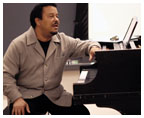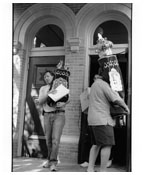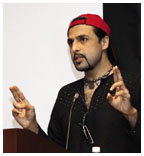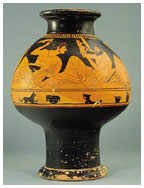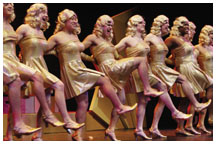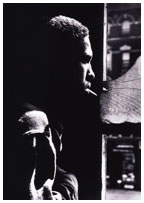
|
|
December 14, 2005: Notebook
Sounds of New Orleans
Jazz pianist ‘Willie Tee’ Turbinton brings his music to Princeton
An effort to save lives, Torahs in New Orleans
Triangle’s back, and oh, those legs!
Wilson “Willie Tee” Turbinton, a New Orleans jazz pianist on campus from October through January, presented some of the musical styles of Mardi Gras during a Nov. 22 lecture. (John Jameson ’04) |
Sounds
of New Orleans
Jazz pianist ‘Willie Tee’ Turbinton brings his
music to Princeton
In an empty lecture space at the Woolworth Music Center, Wilson “Willie Tee” Turbinton sat on the edge of a piano bench in early November, getting acquainted with the black Steinway at his fingertips. After rolling through a long introduction, the 61-year-old jazz and rhythm-and-blues pianist pursed his lips, tapped his left heel, and switched to measured harmonic phrases as he settled into one of his favorite creations. “Can it be done?” he sang. “Is there one — mel-o-dy — that’s never been played?”
Four months ago, Turbinton was a producer and performer in New Orleans, the city where he was born, raised, and mentored by jazz greats such as Julian “Cannonball” Adderley. But when the floodwaters of Hurricane Katrina swept into Turbinton’s neighborhood, he was left with no home and an uncertain future. “I literally lost everything in a flash,” said Turbinton, who had evacuated before the storm hit. “I went home for the first time [in September] expecting the worst, and found worse than the worst.”
Then Turbinton received a phone call from Professor Scott Burnham, the chairman of the University’s music department, asking him to come to Princeton to lecture, perform, and work with student musicians from October through the end of January. The offer was part of the University’s effort to reach out to those displaced by the storm. With faculty and students already coming to campus, President Tilghman and Burnham had talked about bringing part of New Orleans’ rich musical community on board as well, and Turbinton was the top candidate. In his first few weeks on campus, he said, it had already been a “very warm” experience.
The timing was perfect for Princeton’s jazz program, which has grown under the direction of senior lecturer Tony Branker ’80, who spent this fall in Estonia on a Fulbright fellowship. Students had asked Burnham for more access to professional musicians, and Turbinton has added a third perspective to the group of jazzmen on campus that includes saxophonist Ralph Bowen, a visiting associate professor from Rutgers, and drummer Ralph Peterson, a visiting lecturer and leader of the Ralph Peterson Fo’tet. “Willie is going to really help us give that extra little oomph to our flourishing jazz program,” Burnham said. “At the same time, for the campus at large, he will provide a real connection to something at the heart of New Orleans.”
For Burnham, whose scholarship has favored Beethoven over bebop, finding an ambassador of New Orleans jazz required some research. He spoke with nonprofit groups in the jazz community as well as with humanities professor Toni Morrison, who spoke with Wynton Marsalis at a PBS benefit for Katrina victims in September. Marsalis recommended Turbinton, and the following week, Burnham called Turbinton’s cell phone. Turbinton was not sure what to make of Burnham’s first call, he said. But after some hesitation, he decided that the opportunity to share his passion for jazz was too good to pass up.
Settling into the academic life, Turbinton spent part of the fall break in his small office in Woolworth, equipped with basic necessities: a portable stereo, a handful of CDs, a laptop computer, a telephone, and a set of keys that unlock the building’s rehearsal studios. In his interactions with students, Turbinton said he wants to pass along subtle tricks of technique as well as his personal experiences with jazz innovators. But above all, he said, he wants to be a “catalyst of encouragement.”
A recording artist since his teenage years, Turbinton has played for
packed rooms in spots from the French Quarter to the United Kingdom. (To
undergraduates, his most recognizable tune may be “Concentrate,”
which was sampled on a 1997 Puff Daddy album.) And while his heart may
be in New Orleans, his passion for music accompanied him on the trip north.
“One of the things that Cannonball Adderley told me is that no matter
how great you might think you are, you can only play in one venue at a
time,” Turbinton said. “And if you’re playing in a venue
and the people are really enjoying it, then you’re the greatest
thing that ever happened at that particular moment.” ![]()
By B.T.

An effort to save lives, Torahs in New Orleans
Erich Sternberg ’90, left, carries a Torah out of a New Orleans synagogue. (© JOSHUA MANN PAILET/A Gallery for Fine Photography) |
Until the end of August, Erich Sternberg ’90 needed only an hour or two a month to fulfill his volunteer role as president of the Jewish Federation of Greater Baton Rouge (La.). Then the hurricanes struck the Gulf Coast.
In the wake of Hurricanes Katrina and Rita, Sternberg worked countless hours to save people and Torahs from the flooding in New Orleans. He raised nearly $3 million for those displaced, and worked toward rebuilding a Baton Rouge synagogue.
Sternberg helped organize search-and-rescue missions after Katrina for residents of New Orleans, 75 miles east of Baton Rouge. Leaders of New Orleans’ Jewish community, who had evacuated to Houston, sent names of people of all faiths who did not evacuate New Orleans. Sternberg organized vans and drivers to take volunteers and law-enforcement officers to the Crescent City. He contacted family members of evacuees and helped coordinate shelter and triage efforts at Baton Rouge’s two synagogues.
Next, Sternberg and 17 others drove to New Orleans to remove 25 Torahs from three synagogues and a Jewish community center. They wanted to save the handwritten scrolls from the elements and from possible looting.
“The Torah rescue was quite emotional for everyone involved,” Sternberg said. “No one I have spoken with can recall a similar operation taking place in North America. We hope it will be the last.”
There was no power in the city, and Sternberg’s group used flashlights in the synagogues to find the Torahs. “I will never forget how quiet the streets of New Orleans were that day,” Sternberg said.
Nearly a month after Katrina, Hurricane Rita heavily damaged Beth Shalom Synagogue in Baton Rouge. Sternberg, an insurance executive, has worked with the synagogue on its insurance claim and on securing other reconstruction funds.
“Our current focus is looking beyond 2006,” Sternberg said.
“We expect Baton Rouge to grow considerably and the Jewish population
also to retain much of its new population.” ![]()
By Sonny Marks

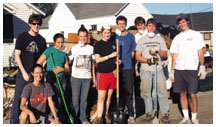 |
During fall break, about 20 undergraduates from the Student Volunteers Council traveled to Louisiana and Alabama to assist residents and clean up the damage left by Hurricanes Katrina and Rita. Stephanie Feldstein ’08, one of nine students volunteering in Abbeville, La., kept a journal of her experiences for PAW. The town of Abbeville is north of Vermilion Bay, which opens into the Gulf of Mexico.
Monday, Oct. 31 The town of Erath, a few minutes from Abbeville, had opened its arms to the victims of Hurricane Katrina, providing them with food and shelter after the disaster. Just weeks later, Rita hit them hard, and though no lives were lost, a quick drive to our site showed the physical damage it had done.
We soon met Melba and Charles Tibideaux, an elderly Cajun couple who had lived in their home for 38 years and raised 11 foster children in it. They loved their house and wanted it saved, and we wanted to save it. Wearing masks for protection from the pervasive smell (and spores) of mold and mildew, some of the boys helped remove their furniture while the rest of us took out the floors. With only a few shovels and a crowbar for tools, it was tough manual labor. Perhaps a little too eager to help, we shoveled until our hands were covered with blisters and our arms had progressed to a near-arthritic state. By day’s end, we were tired and sore, but the floors were almost gone.
Tuesday, Nov. 1 Munching on snacks from the Red Cross, I listened as Melba told me about picking cotton on her father’s farm as a child, about her daughter’s beauty pageants and her granddaughters’ report cards. The conversation turned to the hurricane.
“I had so many photos on the wall, all ruined,” she said. “My daughter’s wedding dress, her wedding photos, all gone. Our house is all we have left, and we don’t even have the money to rebuild it. FEMA said they would give us a trailer, but it hasn’t come yet. Maybe in a year — maybe two. Either way, a trailer isn’t home.”
Friday, Nov. 4 The local senior center, our next site, was filled with mud, and we spent most of the day throwing away furniture, TVs, and bingo cards encased in mud and mold. At the end of the day, Elbert Dawson, our boss from Vermilion Faith Community of Care, helped us clean the floors with a hose and mop. I wondered why we were cleaning, since the floors had to be taken out anyway.
“So people aren’t afraid to come in here anymore,” Elbert said. “They can look and see it fairly clean and think, ‘Maybe things aren’t so bad after all.’”
Saturday, Nov. 5 After saying our goodbyes we were back on the plane,
headed for Newark. No one wanted to leave. There was so much left to be
done. I had seen houses destroyed, lives changed, mementos forever gone
— but more importantly, I had seen triumph. The cooperation and
hard work I witnessed was utterly amazing. We may not have rebuilt Louisiana
during fall break, but we had some impact on the lives of the people we
were able to assist. ![]()

Photo by Celene Chang ’06 |
“All these people [the mullahs] have a gig, they have people who come listen to them on Friday, and they’re afraid of losing that gig ... because all those people might go to a rock concert instead. There’s this giant denial going on — that’s why I wanted to have a conversation and learn a different perspective.”
Pakistani rock musician Salman Ahman on why he interviewed Pakistani
mullahs, who condemn music as against Islam, for his documentary film,
The Rock Star and the Mullah. Ahman spoke after a showing of
the film Nov. 17 in McCormick Auditorium.
![]()

Princeton’s psykter (PUAM) |
Two ancient Greek vases in the University Art Museum’s collection are among the items of interest to Italian authorities investigating whether prominent American museums acquired illegally excavated artifacts.
Italian prosecutors requested details in December 2004 of the Princeton museum’s acquisition in 1989 of two painted ceramic vases. The information was provided last January, the museum said in a statement issued in November, adding that there has been no further communication from the authorities.
“The museum purchased these vases in good faith and has no knowledge of any wrongdoing associated with their acquisition,” said museum director Susan M. Taylor. “If proof of illegality is presented to the museum, the vases will be returned, as we have returned other items in the past.”
At issue are a 12-inch-tall Athenian red-figure vase for cooling wine, or psykter, dating to 510-500 B.C., and a 22-inch-tall Apulian red-figure loutrophoros (a slender long-necked vase) from about 330 B.C.
Antiquities dealer Giacomo Medici was convicted last year of receiving and exporting stolen items from ancient tombs. His co-defendants, American dealer Robert Hecht and Marion True, former antiquities curator of the J. Paul Getty Museum in Los Angeles, went on trial in Rome Nov. 16.
Rome prosecutor Paolo Ferri said the psykter at Princeton originated with Medici, Bloomberg News reported. Bloomberg quoted Ferri as saying that the University museum has “many, many items whose provenance is Medici.”
The museum denied that charge. “A search of museum records finds no indication that we have acquired anything at all from Mr. Medici, either directly or indirectly,” said Ruta Smithson, spokeswoman for the museum.
The art museum’s policy requires “extensive due diligence in researching all objects” before an acquisition is made, according to the November statement. Taylor added that the museum has a long history of cooperating with Italy “in matters of disputed provenance, and we trust that this will continue.”
In addition to the art museum, institutions cited in Italian court records
as being suspected of having looted objects from Italy are the Getty Museum,
the Metropolitan Museum of Art in New York, the Minneapolis Institute
of Arts, the Museum of Fine Arts in Boston, and the Toledo Museum of Art.
![]()
By W.R.O.

Architect's rendering of the five-story, L-shaped 1981 Hall, which will house 111 undergraduates. (Princeton Communications) |
A dormitory in Whitman College will be named 1981 Hall to recognize a gift from a group of class members who choose to remain anonymous. It will be the first Prince-ton dorm to be named after a class that graduated after World War II, as well as the first dorm to honor a coed class.
“We are so proud to have a Princeton dormitory named for our class, especially as we gear up for what we hope will be a spectacular 25th reunion,” said class president Jean Telljohann.
Whitman College, which is under construction and scheduled to open in
the fall of 2007, will include seven dorms housing 500 undergraduate and
10 graduate students. It is a central part of the University’s four-year
residential college plan. ![]()

JOSEPH GREENBERG *77, the University registrar, died Nov. 6 of complications from brain cancer. He was 58. Greenberg joined the registrar’s office in 1978 as assistant registrar after a year as a lecturer in the English department, directing the expository writing program.
ROBERT KUENNE, a noted economist and professor at Princeton for 41 years,
died of Lou Gehrig’s disease Nov. 5 at home in Princeton. He was
81. Kuenne, who joined the faculty in 1956, designed and taught for 30
years the course “Analyses of Capitalism.” He was a consultant
for many years to the Institute for Defense Analyses. ![]()

(Photo by Frank Wojciechowski) |
Triangle’s back, and oh, those legs!
The Triangle Club’s fall show, “Excess Hollywood,”
will be on tour – complete with kickline – in December after
making its debut Nov. 11 at McCarter Theatre. A political and cultural
satire of the film industry, the production is the club’s first
complete “book show” — a cohesive story, rather than
a series of sketches — in more than a decade. Shows are scheduled
in New York, Washington, D.C., Chicago, Cleveland, Detroit, Cincinnati,
and Indianapolis. ![]()

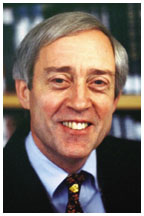
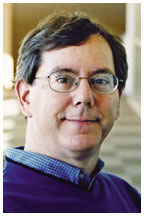 GEORGE RUPP ’64
(left), president of the International Rescue Committee, will receive
the Woodrow Wilson Award and ARTHUR LEVINSON *77 (right),
chairman and CEO of Genentech, will receive the James Madison Medal on
Feb. 25 at Alumni Day ceremonies. The awards are the University’s
highest honors for alumni. Rupp is a former president of Rice and Columbia
universities; Levinson joined Genentech as a senior scientist in 1980.
GEORGE RUPP ’64
(left), president of the International Rescue Committee, will receive
the Woodrow Wilson Award and ARTHUR LEVINSON *77 (right),
chairman and CEO of Genentech, will receive the James Madison Medal on
Feb. 25 at Alumni Day ceremonies. The awards are the University’s
highest honors for alumni. Rupp is a former president of Rice and Columbia
universities; Levinson joined Genentech as a senior scientist in 1980.
In the days following his nomination as a U.S. Supreme Court justice, SAMUEL A. ALITO ’72’s Princeton ties provided some news. First, it was reported that Alito’s senior thesis — on the Italian court system — was missing, one of nearly 300 that vanished before they could be archived in Mudd Manuscript Library, according to University Archivist Daniel J. Linke. But Alito’s thesis adviser, emeritus professor of politics Walter F. Murphy, had retained a copy of the thesis, and he loaned it to the University to make a digital copy. Among the stories resulting from an analysis of the thesis was an AP report that Alito “favored equal treatment for men and women in adultery cases.”
A week later, a 1985 job application was released in which Alito — seeking to demonstrate his conservative views — included his membership in the Concerned Alumni of Princeton, a group founded in 1972 to try to move the University in a more conservative direction. That report led a liberal group, People for the American Way, to ask for access to CAP records in the archive of former National Review publisher William A. Rusher ’44, stored at the Library of Congress.
PRESIDENT TILGHMAN received total compensation of $564,619
in 2003–04, according to a Chronicle of Higher Education survey.
The figure includes a salary of $514,375, up 6 percent from the previous
year, and benefits of $50,244; also reported was expense compensation
of $65,823 for the rental value of a house and $2,322 for life insurance.
The Chronicle listed 50 private university presidents who earned $500,000
or more; within the Ivy League, Tilghman ranked sixth in both base salary
and total compensation. ![]()

(Red Jackson by Gordon Parks/© 1948 Gordon Parks) |
BETWEEN IMAGE AND CONCEPT, on display through Feb. 26 at the University Art Museum, highlights the museum’s recent acquisitions in African-American art. The exhibition offers “a cross-section of figurative and abstract works from the past century that present the black experience from a variety of perspectives,” said Laura M. Giles, curator of prints and drawings. The museum has added more than 30 works to its African-American collection in the past five years.
Julian Savulescu, ethics professor at Oxford, will speak “IN DEFENSE OF PERFORMANCE ENHANCEMENT IN SPORTS” Wednesday, Dec. 14, at 4:30 in McCormick 101. Craig Masback ’77, a star runner at Princeton and now the CEO of USA Track and Field, will speak in response. The sponsor is the Center for Human Values.
The ENGELCHOR CONSORT, four Princeton-area women who specialize in medieval and Renaissance music, will perform at 1:30 and 3 p.m. Sunday, Dec. 18, at the University Art Museum. The free concert is titled “A Splendid Time: Music of 15th-Century Europe.”
Undergraduates will present Gilbert and Sullivan’s operetta PATIENCE Jan. 13 and 14 at 8 p.m. in Richardson Auditorium. David Kellett, a vocal instructor, will direct students enrolled in Music 214, “Projects in Vocal Performance”; members of the Glee Club will form the chorus. Richard Tang Yuk, senior lecturer in music, will conduct members of the University Orchestra. Tickets are free.
MARVALENE HUGHES, president of Dillard University,
and the Rev. Charles Adams of Detroit are scheduled to speak Monday, Jan.
16, at the annual Martin Luther King Day Celebration in Richardson Auditorium.
Princeton and Brown universities are working to help Dillard restore operations
after it was heavily damaged by flooding in the wake of Hurricane Katrina.
The event will also recognize essay, poster, and video contest winners
from New Jersey schools. Seating starts at 1 p.m. ![]()

